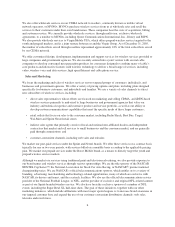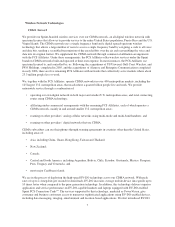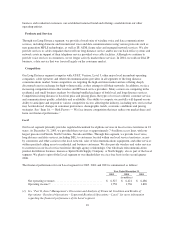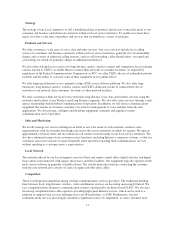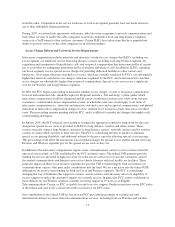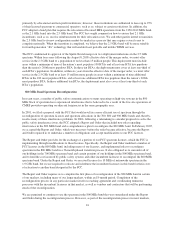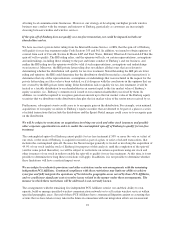Sprint - Nextel 2005 Annual Report Download - page 27
Download and view the complete annual report
Please find page 27 of the 2005 Sprint - Nextel annual report below. You can navigate through the pages in the report by either clicking on the pages listed below, or by using the keyword search tool below to find specific information within the annual report.primarily by educational and non-profit institutions; however, these institutions are authorized to lease up to 95%
of their licensed spectrum to commercial operators, such as us, subject to certain restrictions. In addition, the
FCC adopted a band plan that requires the relocation of licensed BRS operations from the 2150-2162 MHz band,
or the 2.1 GHz band, into the 2.5 GHz band. The FCC has sought comment on how to ensure that 2.1 GHz
incumbents, such as us, receive reimbursement for their relocation costs. We and other parties intend to transition
the 2.5 GHz band to its new configuration market-by-market in a process that may require several years to
complete nationally. When the transition is completed, we believe that the 2.5 GHz band will be more suitable
for fourth generation “4G” technology that will enable fixed, portable and mobile WIMS services.
The FCC conditioned its approval of the Sprint-Nextel merger on two deployment milestones in the 2.5 GHz
spectrum. Within four years following the August 8, 2005 effective date of the merger order, we must offer
service in the 2.5 GHz band to a population of no less than 15 million people. This deployment must include
areas within a minimum of nine of the nation’s most populous 100 BTAs and at least one BTA less populous
than the nation’s 200th most populous BTA. In these ten BTAs, the deployment must cover at least one-third of
each BTA’s population. In addition, within six years from the effective date of the merger order, we must offer
service in the 2.5 GHz band to at least 15 million more people in areas within a minimum of nine additional
BTAs in the 100 most populous BTAs, and at least one additional BTA less populous than the nation’s 200th
most populous BTA. In these additional ten BTAs, the deployment must also cover at least one-third of each
BTA’s population.
800 MHz Band Spectrum Reconfiguration
In recent years, a number of public safety communications systems operating on high-site systems in the 800
MHz block of spectrum have experienced interference that is believed to be a result of the low-site operations of
CMRS providers operating on adjacent frequencies in the same geographic area.
In 2001, we filed a proposal with the FCC that would result in a more efficient use of spectrum through the
reconfiguration of spectrum licenses and spectrum allocations in the 700, 800 and 900 MHz bands and, thereby,
resolve many of these interference problems. In 2004, following a rulemaking to consider proposals to solve the
public safety interference issue, the FCC adopted a Report and Order that included new rules regarding
interference in the 800 MHz band and a comprehensive plan to reconfigure the 800 MHz band. In February 2005,
we accepted the Report and Order, which was necessary before the order became effective, because the Report
and Order required us to undertake a number of obligations and accept modifications to our FCC licenses.
The Report and Order provides for the exchange of a portion of our FCC spectrum licenses, which the FCC is
implementing through modifications to these licenses. Specifically, the Report and Order modified a number of
FCC licenses in the 800 MHz band, including many of our licenses, and implemented rules to reconfigure
spectrum in the 800 MHz band in a 36-month phased transition process. It also obligated us to surrender all of
our holdings in the 700 MHz spectrum band and certain portions of our holdings in the 800 MHz spectrum band,
and to fund the cost incurred by public safety systems and other incumbent licensees to reconfigure the 800 MHz
spectrum band. Under the Report and Order, we received licenses for 10 MHz of nationwide spectrum in the
1.9 GHz band, but we are required to relocate and reimburse the incumbent licensees in this band for their costs
of relocation to another band designated by the FCC.
The Report and Order requires us to complete the first phase of reconfiguration of the 800 MHz band in certain
of our markets, including many of our larger markets, within an 18-month period. Completion of the
reconfiguration process in any particular market involves reaching agreement and coordinating numerous
processes with the incumbent licensees in that market, as well as vendors and contractors that will be performing
much of the reconfiguration.
We are permitted to continue to use the spectrum in the 800 MHz band that was surrendered under the Report
and Order during the reconfiguration process. However, as part of the reconfiguration process in most markets,
16


